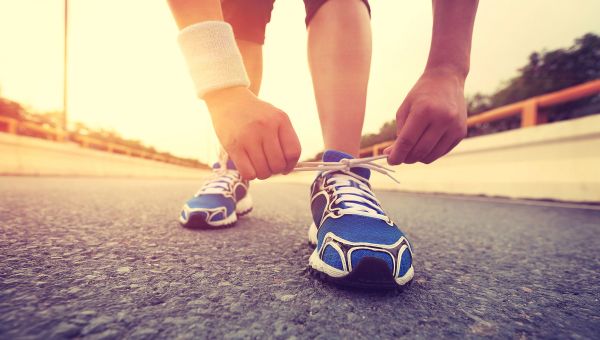How to develop healthy habits, 5 minutes at a time
Cultivating wellness takes time, but you can get started today with these five moves.
Updated on February 13, 2023

If you’ve ever worked on improving your health—whether by getting in better physical shape, renovating your diet, or optimizing your sleep habits—you know that the best results involve developing solid, lasting habits. That kind of work takes commitment, but the good news is that you don’t need to devote hours each day to it.
“It’s not that you can say, I’m going to take… Show More
If you’ve ever worked on improving your health—whether by getting in better physical shape, renovating your diet, or optimizing your sleep habits—you know that the best results involve developing solid, lasting habits. That kind of work takes commitment, but the good news is that you don’t need to devote hours each day to it.
“It’s not that you can say, I’m going to take these three days and get myself healthy,” says Keith Roach, MD, associate professor in clinical medicine in the division of general medicine at Weill Cornell Medical College in New York City. “That won’t work. What makes you healthy and keeps you healthy are the everyday activities that you do.”
Here are five changes you can make, in just a few minutes each day, to feel healthier and boost your long-term well-being.
Show Less
Get outside and move
Hitting a treadmill or outdoor trail is a smart idea for your health, but did you know that running just 5 to 10 minutes a day can give your fitness a significant boost? In a 2022 study published in JAMA Internal Medicine, researchers found that just 10 minutes more per day of moderate-to-vigorous… Show More
Hitting a treadmill or outdoor trail is a smart idea for your health, but did you know that running just 5 to 10 minutes a day can give your fitness a significant boost? In a 2022 study published in JAMA Internal Medicine, researchers found that just 10 minutes more per day of moderate-to-vigorous physical activity (MVPA) was tied to almost 7 percent fewer deaths per year in adults over 40 years of age.
You may even be able to enjoy the benefits of MVPA in fewer than ten minutes. A review of research published in 2020 in Medicine & Science in Sports & Exercise found that shorter daily bouts of MVPA were linked to several positive health outcomes, including lower risk of high blood pressure and improved cholesterol and blood glucose levels. A 2019 review published in Circulation Research reached similar conclusions. Researchers noted that while the Physical Activity Guidelines for Americans call for 150 minutes per week of moderate-intensity aerobic physical activity or 75 minutes per week of vigorous activity, exercising for smaller periods of time can also have health benefits.
When it comes to exercise, a little goes a long way. Even short bursts of movement throughout the day add up to big benefits.
Show Less
Spend less time on the sofa
Do you tend to flop out on the couch when you get home? A little rest is a good thing, just try not to stay there for the rest of the day. Inactivity ranks high among behaviors that increase the risk of heart disease, according to the Centers for Disease Control and Prevention (CDC). The good news?… Show More
Do you tend to flop out on the couch when you get home? A little rest is a good thing, just try not to stay there for the rest of the day. Inactivity ranks high among behaviors that increase the risk of heart disease, according to the Centers for Disease Control and Prevention (CDC). The good news? A study published in 2019 in the Journal of the American College of Cardiology found that for people who sit a lot—more than 6 hours each day—replacing just one hour of daily sitting time with walking meant a 22 percent lower risk of death from all causes.
“Humans weren’t meant to sit for long periods,” says Dr. Roach. “Your heart needs to work.”
Standing more isn’t a perfect remedy for sitting, however, since it can be hard on your feet and knees. It’s ideal to strike a balance between sitting, standing, and moving throughout the day. If you have a desk job, try using a standing desk to break things up, and take short breaks to stand, stretch, and move every hour.
Show Less
Make a Date
Making social connections can offer great health benefits. But it takes more than chatting with a pal during the big game or the latest episode of Stranger Things. “What’s important is having someone you can talk to about big, important things,” says Roach. “Confiding in someone else and letting… Show More
Making social connections can offer great health benefits. But it takes more than chatting with a pal during the big game or the latest episode of Stranger Things. “What’s important is having someone you can talk to about big, important things,” says Roach. “Confiding in someone else and letting them confide in you will boost your health.”
Sending texts or emails can get things started, but they aren’t always enough. “By phone or in person is best,” Roach explains. “It’s hard to put emotional context in typing, and that’s what this is really about.”
Show Less
Fill your plate with produce
You know that eating fruits and veggies is good for you, but did you know it’s linked to a lower chance of premature death? A meta-analysis of 26 studies published in Circulation in 2021 found that people who ate the most fruits and vegetables had a significantly lower risk of death from any… Show More
You know that eating fruits and veggies is good for you, but did you know it’s linked to a lower chance of premature death? A meta-analysis of 26 studies published in Circulation in 2021 found that people who ate the most fruits and vegetables had a significantly lower risk of death from any cause than those who ate the least. Eating two servings of fruit and three servings of vegetables daily had the best effect.
Leafy green and cruciferous veggies and fruits and veggies high in vitamin C and beta carotene seemed to be particularly beneficial. Think kale, broccoli, and Brussels sprouts; bell peppers, citrus, and strawberries; and carrots, sweet potatoes, and cantaloupe.
Show Less
Take a break
“We’re always running around trying to do things,” says Roach, and it can be very easy to think you’re simply too busy at work or home to take time for yourself. Think again.
Just five minutes of practicing mindfulness, relaxation, or breathing techniques can reduce stress—and the break… Show More
“We’re always running around trying to do things,” says Roach, and it can be very easy to think you’re simply too busy at work or home to take time for yourself. Think again.
Just five minutes of practicing mindfulness, relaxation, or breathing techniques can reduce stress—and the break may even help with your work.
“Relaxing for five minutes can help your mind focus,” says Roach. “It also helps you get centered, decreases those stress levels and stress hormones and does lots of good things for your body.”
Show Less
Saint-Maurice PF, Graubard BI, Troiano RP, et al. Estimated Number of Deaths Prevented Through Increased Physical Activity Among US Adults. JAMA Intern Med. 2022;182(3):349–352.
Jakicic JM, Kraus WE, Powell KE, et al. Association between Bout Duration of Physical Activity and Health: Systematic Review. Med Sci Sports Exerc. 2019;51(6):1213-1219.
Lavie Carl J, Ozemek Cemal, Carbone Salvatore, et al. Sedentary Behavior, Exercise, and Cardiovascular Health. Circulation Research. 2019;124:799–815.
U.S. Department of Health and Human Services. Physical Activity Guidelines for Americans, 2nd Edition. Washington, DC; 2019.
Centers for Disease Control and Prevention. Know Your Risk for Heart Disease. Page last reviewed December 9, 2019.
Stamatakis E, Gale J, Bauman A, et al. Sitting Time, Physical Activity, and Risk of Mortality in Adults [published correction appears in J Am Coll Cardiol. 2019 Jun 4;73(21):2789]. J Am Coll Cardiol. 2019;73(16):2062-2072.
Carbone S, Ozemek C, Lavie CJ. Sedentary Behaviors, Physical Inactivity, and Cardiovascular Health: We Better Start Moving!. Mayo Clin Proc Innov Qual Outcomes. 2020;4(6):627-629.
Wang DD, Li Y, Bhupathiraju SN, et al. Fruit and Vegetable Intake and Mortality: Results From 2 Prospective Cohort Studies of US Men and Women and a Meta-Analysis of 26 Cohort Studies. Circulation. 2021;143(17):1642-1654.
More On


video

article

slideshow


video


video
